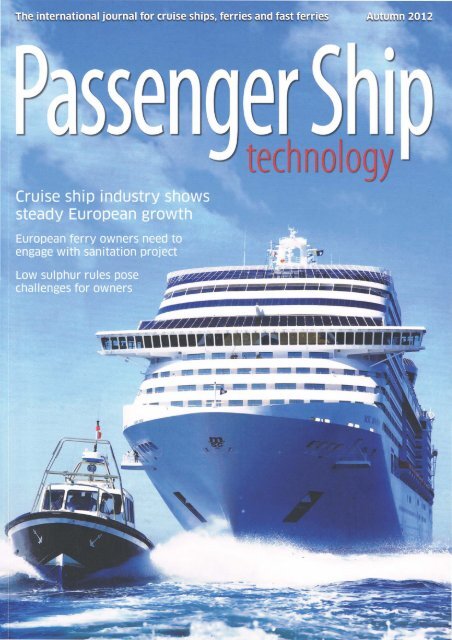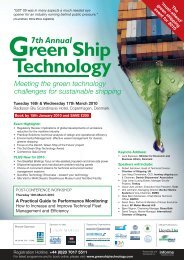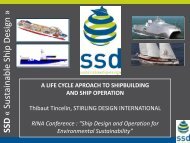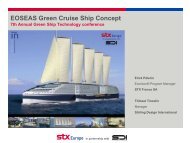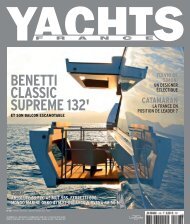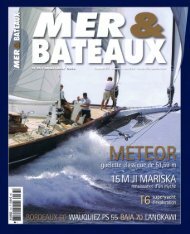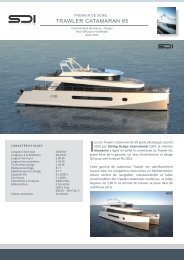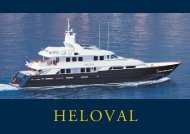Passenger Ship - Stirling Design International
Passenger Ship - Stirling Design International
Passenger Ship - Stirling Design International
Create successful ePaper yourself
Turn your PDF publications into a flip-book with our unique Google optimized e-Paper software.
!..or·enr Agglomération's 22m electric<br />
~rry :,r Vag Tredon is a world first
Ar.. .Y.Prt. T.redp _("l ferry profile<br />
Commuter craft<br />
prototype creates<br />
• •<br />
no em1ss1ons<br />
The supercapacitor power of new 22m catamaran, Ar Vag<br />
Tredan, is a world first for one French agglomeration and<br />
yard group STX Europe<br />
WHEN the Lorient Agglomération in France was granted full<br />
operational control of the city's public transport system in 2008,<br />
one of its highest priorities was to modernise its ferry fleet.<br />
lts elected representatives specified that any new ferries must<br />
have zero emissions, so its transportation department set about<br />
finding a solution to this brief.<br />
Following a tendering process involving 16 international<br />
yards, Lorient Agglomération chose the local Lorient branch<br />
of STX Europe to build a 22m catamaran powered by electrical<br />
supercapacitors- a world first. "We chose STX because it was<br />
the only proposai which met our specifications; we did not<br />
choose it because it is a local yard - that was just an added<br />
bonus," commented Lorient Agglomération's transport director,<br />
André Douineau. "When we did a technical analysis considering<br />
the high workload of 28 return trips a day and the through life<br />
costs, it was clear that STX's proposai was the best.<br />
"Even though the initial priee of the ship was more expensive<br />
than some of the other proposais, these ones were relying on<br />
hybrid diesel or hydrogen power. Over the 30 years we want<br />
this ship to opera te, fuel costs are Jikely to be much higher than<br />
electricity. Therefore this ferry is more economical."<br />
Mr Douineau praised the working relationship with the yard.<br />
"We have had great co-operation with STX. They worked with<br />
us to perfectly adapt the ship to our needs. They even consulted<br />
the crew and asked them for feedback on the design and<br />
equipment," he added. "This is such a technologically advanced<br />
ship with no smoke and no vibration, soit is more comfortable<br />
for passengers too."<br />
STX developed the design with fellow French company,<br />
<strong>Stirling</strong> <strong>Design</strong> <strong>International</strong>. The yard group originally conceived<br />
the idea of using supercapacitors to power a vesse! tlu·ough its<br />
Ecorizon research and development progranune, which aims to<br />
reduce the envi.ronmental impact of ships.<br />
"Supercapacitors are a very safe and dean way to store<br />
power," said Mathieu Lelievre, project manager at STX Lorient.<br />
"They discharge electricity on board that they receive from the<br />
shore grid." A total of 128 supercapacitors have been installed<br />
on this new ferry, Ar Vag Tredan (the na me means 'the electrical<br />
ship' in the Breton language). Aluminium cathodes with<br />
nanometric pores store the electricity densely - a surface area of<br />
3,00Qm2 is contained within each gram of material.<br />
The vesse! will ply a lü-minute route between Lorient and<br />
Locmiquélic on the Blavet River in Brittany. The supercapacitors<br />
can only store enough charge for one trip and so have to<br />
recharge using a transformer at the terminal following every<br />
return trip. The two-pin industrial plug is at the "limit of human<br />
handling" according to Mr Lelievre. "We have also provided<br />
some mechanical assistance with a crane. For bigger ships we<br />
wou id develop a different system without plugs, either with<br />
contacts or ignition."<br />
The recharging process only takes four minutes, which<br />
allows the ferry to keep toits schedule of a sailing every quarter<br />
of an hour. It is particularly crucial for the vesse! to be on time<br />
as water transport is integrated with the city's bus timetable.<br />
Buses arrive at and leave each terminal just after the vesse! is<br />
due to dock. Lorient's six ferries are very busy - in 2011 they<br />
transported 770,000 passengers overall and more than 400,000<br />
people on the Lorient to Locmiquélic route alone.<br />
Mr Douineau commented, "It's important for us to have<br />
a quality service but we have a clause in the build contract<br />
to accept up to 14 da ys out of service, as this is a prototype<br />
Operator<br />
Builder<br />
<strong>Design</strong>er<br />
Length<br />
Breadth<br />
Draught<br />
Propulsive power<br />
Service speed<br />
<strong>Passenger</strong>s<br />
Classification<br />
AR VAG TREDAN<br />
Lorient Agglomération<br />
STX Lorient<br />
STX Lorient/<strong>Stirling</strong> <strong>Design</strong> <strong>International</strong><br />
22.1m<br />
7.2m<br />
1.5m<br />
2 x 75kW<br />
10 knots<br />
113 people including 3 people<br />
with reduced mobility and 10 bicycles<br />
Bureau Veritas<br />
www.passengership.info
ferry profile Ar vag Tredan<br />
design. If the ferry is offhire for longer than that, STX has to<br />
pay for each day it is una\·ailable."<br />
STX Lorient's \·ice president of sales and marketing,<br />
Frédéric Deyrieux, believes the technology is reliable.<br />
"Supercapacitors are a proven solution within other types of<br />
transport such as trams and the technology has a recharge and<br />
discharge efficiency of about 98.5 percent. As weil as no gas<br />
emissions, there are no chemicals used, therefore maintenance<br />
is reduced. Each supercapacitor can last for up to 15 years,<br />
e\'en with heavy usage.<br />
"As the vesse! only takes on enough power for one trip, this<br />
makes it lighter, so you require Jess power in the first place.<br />
Supercapacitors are an ideal solution for high frequency short<br />
ferry journeys."<br />
Power to the on board air conditioning will a Iso be provided<br />
by the supercapacitors, through a heat pump. The heat pump<br />
has a coefficient performance factor of six, ie, using 1kW of<br />
electricity produces 6kW of heating or cooling.<br />
The 400V recharging connection is on the bow of the shi p.<br />
"We requested that the electrical connection was separated<br />
from where the passengers board," said Mr Douineau.<br />
<strong>Passenger</strong>s embark using a folding ramp on the port side.<br />
"There probably would not have been a problem with situa ting<br />
the plug near the passenger areas, but we would rather be sa fe<br />
than sorry."<br />
In case the supercapacitors fail, two 100 kY A Cummins Onan<br />
.gensets are installed as back-up power. "If the electrical grid<br />
is not available then the ship can still be operated with two<br />
independent shaftlines," commented Mr Lelievre.<br />
The vesse! is propelled by two Masson Marine azimuth<br />
"This is such a<br />
technologically advanced<br />
ship with no smoke and<br />
no vibration, so it is<br />
more comfortable for<br />
passengers tao"<br />
thrusters. This propeller pump propulsion utilises water flow<br />
driven by a nozzle with fixed blades. They can turn 360 degrees<br />
on either side of the ship and reverse the thrust, enabling good<br />
manoeuvrability in the narrow river passage. This is also why Ar<br />
Vag Tredan could be no longer than 22m, as otherwise it would<br />
not be able to tu rn.<br />
Twenty-four solar panels on top of the ship can deliver<br />
a maximum of 130W each, in total around 5 percent of the<br />
vessel's power. This will feed the low-voltage equipment<br />
on board such as the navigation equipment. Lorient<br />
Agglomération specified two radars instead of the usual one,<br />
and these were supplied by Furuno.<br />
The vesse! also meets French division 190 regulations for
General arrangement otan of Ar Vag Tredan<br />
-<br />
--- - -- - ..= -- ---<br />
;::::..--=------ -<br />
(H~~o §<br />
J<br />
IRF.~ ~<br />
~=:11~CI 0<br />
F==ol<br />
1=<br />
-------<br />
,--f<br />
,•, ,•Jw.passengership.info Possenger <strong>Ship</strong> Technology 1 Autumn 2012 1 27
disabled and reduced mobility passengers. The boarding ramp<br />
can adapt to the angle of the quay using its three hinged sections<br />
to ena ble wheelchairs or children's buggies to pass over it.<br />
Aluminium was selected for the hull due toits light weight.<br />
"We made the lightest structure possible depending on the ru les we<br />
had to build to and the use of the ship," sa id Mr Lelievre. "We a Iso<br />
selected only light components for insulation and piping material -<br />
in fact every ti me we had to choose equipment, we considered the<br />
weight as an important characteristic." For instance, ali the onboard<br />
pumps are constructed from copper and nickel.<br />
The who le design of the ship was realised using computeraided<br />
design/computer-aided manufacturing (CAO/CAM)<br />
software. Mode! tank tests of the hull's hydrodynamics were<br />
performed at the HSVA towing tank in Germany. "The hull lias<br />
a low resistance and we worked on supplying the thrusters<br />
with good vanes," said Mr Lelievre. "In order to have good<br />
efficiency for the thrusters we had to remove volume in the aft<br />
and f01ward [areas]. The supercapacitor installation brought the<br />
centre of gravity forward, as each module is qui te heavy."<br />
Both hull compartments have reasonable volume at 3m<br />
high and 2m wide. As the draught is l.Sm, each compartment<br />
is actually half below the waterline. "This means the vesse! is<br />
not too sensitive to the wi nd, in comparison to monohulls,"<br />
Mr Lelievre commented . The hull has been coated with<br />
<strong>International</strong> Paint silicone antifouling.<br />
Safety equipment specified includes two l OO-people<br />
liferafts and fi re extinguishers. Also installed is 3M's Novec fire<br />
protection fluid in the fire suppression system. This fluoroketone<br />
works as a gas but is liquid at room temperature. It has zero<br />
ozone dep letion potential and can dissipa te in five days.<br />
Just two crew members will be employed on board the<br />
shi p. On deck, forward, there are 10 bicycle racks. Ninety-eight<br />
passenger seats are provided in the passenger lounge.<br />
Upon delivery in September, Ar Vag Tredan w ill replace<br />
Sainte Catherine, which was built back in 1962. Another of the old<br />
ferries, Curseau, will be ta ken out of service as it does not have<br />
two independent shaftlines, as required in !MO regulations, but<br />
will remain available in case of emergencies. Therefore the new<br />
vesse! will run alongside four elderly ferries.<br />
There is an option in the con tract for another vesse!, but<br />
Mr Douineau commented, "It depends on the performance<br />
of this one. A sistership would be slightly diffe rent from this<br />
design though, as it will incorporate ali the modifications we<br />
recommend resulting from the experience of opera ting Ar Vag<br />
Tredan. A decision will not be made for a few years at !east." PST<br />
Supercapacitor supplier<br />
Gensets<br />
Rudders/azimuth thrusters<br />
Antifouling<br />
Liferafts<br />
Sanitary installations<br />
Navigation equipment<br />
EQUIPMENT /OUTFIT<br />
Batscap<br />
Cummins Onan, 2 x 100 kVA<br />
Masson Mar ine<br />
<strong>International</strong> Paint<br />
Survitec Zodiac. 2 x 100 people<br />
STX<br />
Furuno


